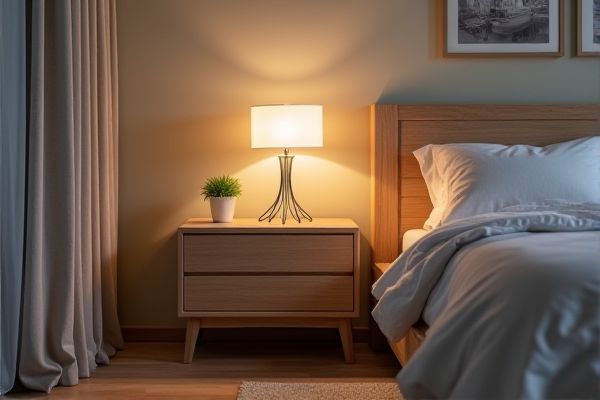
A nightstand usually offers more storage options like drawers or shelves, making it ideal for keeping personal items close, while a bedside table often focuses on a simple surface for essentials like a lamp or clock. Discover which option best suits your bedroom needs and enhances your nighttime routine in the rest of the article.
Table of Comparison
| Feature | Nightstand | Bedside Table |
|---|---|---|
| Purpose | Designed primarily for holding essential items close to bed | Functions as a decorative and functional table next to the bed |
| Storage | Often includes drawers or shelves for storage | May or may not have storage, more open surface space |
| Size | Typically compact and small | Varies from small to medium size, often larger |
| Design | Focus on practicality and convenience | Focus on style and complementing bedroom decor |
| Common Items Placed | Lamps, alarm clocks, books, glasses | Lamps, decor items, books, plants |
| Placement | Placed right next to the bed within arm's reach | Placed next to the bed, sometimes slightly farther |
Understanding the Difference: Nightstand vs Bedside Table
A nightstand and a bedside table both serve as small furniture pieces placed next to your bed but differ slightly in design and function. Nightstands typically feature drawers or enclosed storage, ideal for organizing personal items like books or glasses, while bedside tables often have open surfaces or shelves for easy access. Understanding these distinctions helps you choose the right option to suit your bedroom organization and style needs.
Historical Origins of Nightstands and Bedside Tables
Nightstands and bedside tables both originated from the need for convenient bedroom storage and surface space, with early versions dating back to the 1700s when small cabinets were placed beside beds for personal items and candles. Nightstands traditionally featured drawers for storing nighttime essentials, while bedside tables often had simpler designs with open shelves or tabletops. Your choice depends on whether you prefer the historical functionality of concealed storage or the open accessibility characteristic of bedside tables.
Key Features of a Nightstand
A nightstand typically features one or more drawers and a flat surface to hold essentials like lamps, alarm clocks, or books, allowing you to keep your bedside organized. Its height is designed to align with your bed, making it easy to reach items without disrupting your comfort. Nightstands often include additional storage options, such as shelves or compartments, enhancing functionality compared to a simple bedside table.
What Defines a Bedside Table?
A bedside table is a small, functional piece of furniture placed next to a bed, designed to hold essentials like a lamp, alarm clock, and personal items within easy reach. It often features drawers or shelves for additional storage, enhancing bedroom organization. The defining characteristic of a bedside table is its proximity to the bed, providing convenience and accessibility during nighttime or early morning routines.
Design Styles: Nightstands vs Bedside Tables
Nightstands typically feature a more compact design with built-in drawers for storage, often aligning with modern or minimalist aesthetics to maximize bedroom functionality. Bedside tables offer a wider variety of design styles, from rustic farmhouse to vintage or industrial, serving both practical and decorative purposes. Your choice should reflect the overall bedroom decor and how much storage or surface space you require.
Practical Uses in the Bedroom
Nightstands and bedside tables both serve practical purposes in the bedroom by offering convenient storage and surface space for essential items like lamps, books, and alarm clocks. Nightstands typically feature drawers for organized storage of personal belongings, while bedside tables often provide open shelves or minimalist designs for easy access. Choosing the right piece enhances your bedroom's functionality and accessibility during nighttime routines.
Material and Construction Comparison
Nightstands are commonly crafted from solid wood, offering durability and a classic aesthetic, while bedside tables often incorporate engineered wood or metal, emphasizing modern design and affordability. Construction methods for nightstands typically involve sturdy joinery like dovetail or mortise-and-tenon, enhancing longevity, whereas bedside tables may use simpler assembly techniques such as screws and brackets for ease of manufacturing. Both furniture types prioritize functional design, but material choice significantly influences weight, stability, and overall style.
Storage Options and Functionality
Nightstands often feature multiple drawers and shelves, offering extensive storage solutions for items like books, electronics, and personal belongings. Bedside tables typically provide a simpler design with open or limited storage space, prioritizing easy access to essentials such as lamps or alarm clocks. Choosing between the two depends on the need for concealed storage versus minimalistic surface functionality.
Choosing the Right Piece for Your Space
Nightstands and bedside tables both serve as functional storage and surface space next to your bed, but choosing the right piece depends on your room size and design needs. Nightstands often feature drawers for concealed storage, ideal for keeping essentials like books or glasses out of sight, while bedside tables usually offer open shelves or simpler designs that can make smaller spaces feel less cluttered. Consider your storage preferences and spatial constraints to select a piece that enhances your bedroom's aesthetics and functionality.
Nightstand or Bedside Table: Which Should You Buy?
A nightstand typically features drawers or shelves for storing items like books, glasses, and electronics, making it ideal for those who need extra storage by their bed. A bedside table often has a simpler design, focusing on surface space for essentials such as lamps, clocks, or a glass of water. Consider your storage needs and bedroom aesthetics when deciding between a functional nightstand and a minimalist bedside table.
 homyna.com
homyna.com